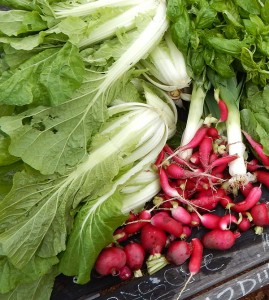Hi, I’m Robert McDougall, a PhD student from the University of New England researching urban agriculture. For the last year I’ve been carrying out a range of studies at MBCG and other gardens throughout Sydney and Wollongong looking at how productive these gardens are and the role that ecosystem services (mainly pollination and control of pests by their natural enemies) play within them. I’m only part way through my research at this stage, but wanted to give everyone an update on some of the things I’ve found thus far.
Productivity
Most community gardeners, when I mention that I’m looking at productivity, tell me that they don’t work in the garden in order to be produce lots of food. They tell me they do it for relaxation, to connect with nature or to access sustainable and ethically sourced food. This is its own kind of productivity and numerous studies have found this aspect of community gardening has significant benefits, however isn’t what I’m researching.
My study is one of the first in Australia to measure the amount of food grown in urban gardens. And the results are surprising; despite most community gardeners insisting they’re in it for the love rather than the produce most of them are still highly productive, producing more with the amount of space they have than many commercial fruit and veg farms. Mort Bay was no exception, producing 1.8kg of crops per m2 of garden bed in the six months from February and August. If this trend continues across the year (or increases, which is more likely as spring and summer are more productive generally), Mort Bay’s productivity will surpass national averages for a whole range of crops like beans, pumpkins and broccoli.
This is a really exciting finding, one I put down mostly to gardeners in the city working hard to get the most out of the small spaces they have. Of course this high productivity comes with trade-offs, one of which is the amount of work required. Community gardeners generally put many more hours of labour into each kilogram of food grown than commercial farmers do, however given that most do it because they enjoy gardening that isn’t necessarily a bad thing.
Ecosystem Services
Community gardeners are well aware that organisms found within the surrounding environment, like bees and birds, can provide important free services by pollinating crops and eating pests. There’s been plenty of research done on large rural farms into how these services can be enhanced through means like planting patches of undisturbed vegetation and avoiding pesticides, however almost no research of this kind has been carried out in urban areas.
Filling this gap is the second component of my study, but I don’t have any data yet as I’m still part way through my experiments. I’ve recently been measuring pollination using ‘sentinel plants’ that I bought into the garden and will soon be looking at natural enemy pest control by measuring the rate at which caterpillars and their eggs are eaten or parasitised in the gardens I’m studying. Hopefully I’ll find some interesting differences in the level of services between sites and will be able to correlate these with physical factors within the gardens and their surrounds, as well as aspects of garden management, to get an idea of what we can do to encourage them.
I’m really fascinated by the productivity results and am looking forward to some interesting ecological data in the next few months. A big thank you to the whole Mort Bay crew for being so welcoming and supportive of my research – I’ll be sure to keep you in the loop as more results become available.